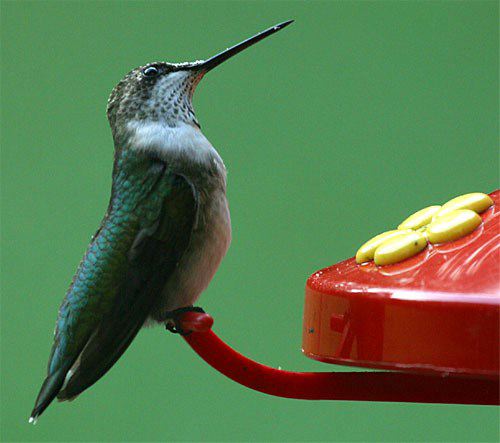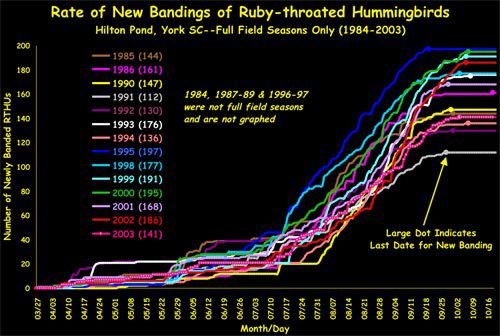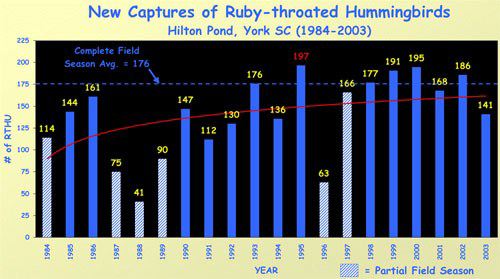 HOME: www.hiltonpond.org |
|||
 HOME: www.hiltonpond.org |
|||
Back to Preceding Week; on to Next Week
|
"SUMMER'S HUMMERS" TIME IS OVER At Hilton Pond Center, our Ruby-throated Hummingbirds-- "summer's hummers" we call 'em-- start arriving as early as the last week in March; many of these "early birds" stop off just long enough to get banded before zooming further north to ancestral breeding grounds. By late April, migrants are still moving, but it's likely that most we band from then through May will nest nearby. In early July, ruby-throat captures begin to increase as the first fledglings start investigating our feeders, and bandings grow almost exponentially throughout August, with the peak coming during the first week in September. Shortly after that, the bottom falls out, and by 1 October about 98% of our work is done for the current season. By now--the third week in October--we're confident there won't be any more ruby-throats because our latest ever was on 18 October. Thus, from this week until next spring, summer's hummers are no more and we'll need to get our hummingbird banding fix from an occasional winter vagrant--such as the fabled Rufous Hummingbird we banded at the Center in November 2001. 
All text, photos & charts © Hilton Pond Center To be honest, we're hopeful we get several wandering winter hummers at Hilton Pond, mostly because 2003 wasn't that great a year for banding local Ruby-throated Hummingbirds. When the spring season began, we thought it might turn out to be a pretty good hummer season, especially when an adult female we trapped on 8 April was earlier--by five days--than any previous ruby-throat of her age and sex. For the rest of April and all of May, new captures proceeded at an average rate, but things slowed down significantly throughout June (click on chart below). By early July we were well below average for that time of year and began to wonder whether we'd even get 100 Ruby-throated Hummingbirds banded by the end of the season. Actually, it was in early-June that we started getting more phone calls and e-mails than usual from hummingbird enthusiasts elsewhere, all wondering what had happened to their hummers this year. Such late-spring contacts aren't unusual; it seems folks often forget there is a lull in hummingbird activity in late May and June when most females are sitting on eggs or chicks and the males sometimes take a short breather from all that aggressive, exhausting behavior that enabled them to establish spring territories. (Note: It's also hard to know just how many hummingbirds you have in your yard without banding them.) Nonetheless, this year we concurred with observers who believed they had lower numbers of ruby-throats than usual and suggested there might be a correlation between an apparent scarcity of hummingbirds and the exceptionally wet, cool weather experienced by much of the eastern U.S. in April and May. We speculated that ruby-throats that came back by mid-April and nested early could have lost first clutches due to blustery conditions; this would mean there were few fledglings in Spring 2003 AND that females that re-nested were sitting tight on their new eggs or broods later than usual. All this, of course, would have resulted in fewer feeder visits and apparent low numbers of hummingbirds. 
Click on chart above for larger view Even though Hilton Pond and lots of other sites did seem to have lower populations of ruby-throats at mid-summer, we got reports from other hummingbird hotbeds at which researchers were capturing and banding "normal" numbers of this species. So we simply kept our usual pace, trying to net and trap ruby-throats each day and telling folks two things: 1) perhaps the expected influx of summer hummers would be late this year, with good numbers of ruby-throats not appearing at feeders until after young from re-nests had fledged; and, therefore, 2) at Hilton Pond we simply wouldn't know if numbers were down until the end of the banding season in mid-October. Fortunately, banding activity at the Center did pick up a bit in late July and continued through early August. The remainder of the month, however, was a disappointment, with day-to-day banding totals dropping again to below-average levels by the end of August (see chart above). Had it not been for a rush of young hummers the first two weeks of September, this year almost certainly would have been our worst since 1984 for banding Ruby-throated Hummingbirds. In the end, we totaled 141 ruby-throats in 2003, our fourth lowest year ever and well below our average of 174 during the previous 13 years for which we were in residence at Hilton Pond Center throughout the hummingbird season (click on chart below). 
Click on chart above for larger view One really peculiar thing is that 2003 is only the second year in which we banded more adult male ruby-throats (19) than adult females (18); perhaps some of the latter perished while trying to incubate during spring storms. It's also interesting that, on average, we caught twice as many adult females in mist nets this year, possibly a sign they were foraging on food sources other than feeders. It may be that those plentiful spring rains brought a bumper crop of Trumpet Creeper that meant more hummers were indeed after natural foods instead of 1:4 sugar water. One thing about our ruby-throats did NOT change in 2003, however: As in almost every year, juvenile males (top and bottom photos) outnumbered young females by almost exactly a 3:2 ratio (see table below).
Ruby-throat returns also were down in 2003, with 26 birds banded in previous years showing up during the season (see table below). This is about average for our 13 full seasons of hummingbird banding but below the trend for the past five years, over which we had an average of 34 returns. (We still think it's remarkable that of the 2,669 Ruby-throated Hummingbirds banded prior to the current season, 326 have returned in at least one later year--an average of more than 12%. This is especially amazing when we consider that ruby-throats fly 2,000 miles or more to Mexico or Central America and somehow manage to find their way back to the same trap at Hilton Pond Center!) Two of the returns captured in 2003 were banded as adult females in 1999 and were not seen again until this year; we wonder where these prodigal after-5th-year birds have been in the interim.
There are far too many variables, of course, to determine whether this year's low totals of new ruby-throats are a true reflection of: 1) environmental factors (e.g., a wet and rainy spring that affected nesting success, or a rather rainy summer that prevented our deploying mist nets); 2) variation in total hours devoted to netting and trapping (compared to other years); 3) something as simple as our being absent from Hilton Pond on a few peak days in August or September (days over which we might have caught another 20 or so birds and raised significantly our total number of birds banded); 4) local habitat changes (e.g., maybe we're doing TOO good a job of letting natural succession take place and the Center is becoming more wooded than some hummers like, or maybe a neighbor has started hanging feeders for hummingbirds or landscaping for them; The inability to precisely understand what variables affect ruby-throats numbers is one reason we find these tiny birds so fascinating, and trying to answer such questions is ample stimulus for us to commit to another season of banding at Hilton Pond Center in 2004. For the next five months, however, we'll miss our "summer's hummers" while we spend the winter looking for vagrants and pondering charts and tables to see if we can figure out if 2003 really was a bad year for Ruby-throated Hummingbirds. "This Week at Hilton Pond" is written and photographed by Bill Hilton Jr., executive director of Hilton Pond Center for Piedmont Natural History. You may wish to consult our Index of all nature topics covered since February 2000. You can also use the on-line Search Engine at the bottom of this page. For a free, non-fattening, on-line subscription to "This Week at Hilton Pond," just send us an e-mail with "Subscribe" in the subject line. |
|||||||||||||||||||||||||||||||
|
Make direct donations on-line through
Network for Good: |
|
|
LIKE TO SHOP ON-LINE?
Donate a portion of your purchase price from 500+ top on-line stores via iGive: |
|
|
Use your PayPal account
to make direct donations: |
|
|
|
|
SPECIES BANDED THIS WEEK: * = New species for 2003 WEEKLY BANDING TOTAL 1 species 1 individuals
YEARLY BANDING TOTAL (2003) 58 species 972 individuals
BANDING GRAND TOTAL (since 28 June 1982) 123 species 43,086 individuals |
NOTABLE RECAPTURES THIS WEEK
VAGRANT HUMMINGBIRDS A hatch-year male Rufous Hummingbird was banded on 20 Oct at Columbus NC.
OTHER SIGHTINGS OF INTEREST --Due to a trip to Florida to train teachers in the GLOBE/Operation RubyThroat observation protocols, we were away from Hilton Pond Center for most of the week. The next training workshop--this one open also to NON-educators--is in Columbia on 1 Nov in conjunction with the South Carolina Wildlife Federation. Details at Habitat Extravaganza. |
|
|
|
Up to Top of Page Back to This Week at Hilton Pond Center Current Weather Conditions at Hilton Pond Center |
 You can also You can alsopost questions for The Piedmont Naturalist |
Join the |
Search Engine for |
|
|